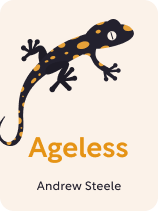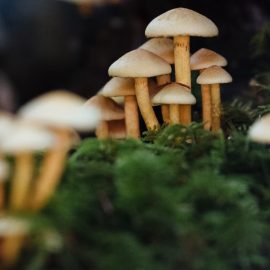

This article is an excerpt from the Shortform book guide to "Ageless" by Andrew Steele. Shortform has the world's best summaries and analyses of books you should be reading.
Like this article? Sign up for a free trial here.
What’s the biology of aging? What types of structures harm your body as they deteriorate?
A process key to aging is the deterioration of structures and signals within and between your cells. In Ageless, Andrew Steels explains that these structures and signals play a role in many diseases and dysfunctions associated with aging.
We’ll take a look at five structures and signals that do extensive damage as they deteriorate.
1. Telomeres Shorten
To explain the biology of aging, we’ll first discuss how telomeres shorten. Telomeres are protective structures at the end of your chromosomes that prevent them from becoming frayed or tangled, but they get shorter as the cell divides repeatedly. Steele explains that telomeres help ensure your DNA replicates correctly when a cell divides. However, the machinery that completes this process can’t copy the full length of the chromosome, so the very end of the telomere is lost each time. Shortened telomeres appear in patients with diabetes, heart disease, reduced immunity, and cancer, and are associated with a higher risk of death.
The potential fix: Steele explains that an enzyme called telomerase might help. It’s disabled in most adult cells, and adding an extra copy of the telomerase gene helps a cell live on. But, he cautions that this might not be wise, since 90% of cancers turn telomerase back on (enabling cells to divide continuously). Other ideas include using gene therapy to lengthen telomeres directly, or employing telomerase activators (like a chemical called TA-65) to reactivate telomerase genes temporarily to reap the benefits of the enzyme without significantly increasing cancer risk.
| Do Telomeres Live Up to the Hype? In The Telomere Effect, biochemist Elizabeth Blackburn compares telomeres to aglets, the protective tips that keep shoelaces from fraying as they sustain wear and tear. In addition to ensuring all the critical information in your DNA gets copied properly, your telomeres help your body enforce the Hayflick limit: the number of times—usually 40 or 60—that each of your cells can divide. Once a cell divides enough times, the telomere becomes too short for the chromosome it protects to be replicated again, so the cell stops dividing. When the link between a person’s age and the length of their telomeres was first discovered, some scientists (and many longevity enthusiasts) thought lengthening telomeres was the key to curing aging. After all, helping cells extend their telomeres offers a way around the Hayflick limit. This seemed even more promising because Blackburn discovered that in healthy cells, telomeres rebuild themselves with telomerase, which lengthens the strand of DNA before it gets copied. But it turns out that striking a balance is tricky: If telomerase is underactive, chromosomes shorten and cells die. But if telomerase is overactive, cancer risk is elevated. While Steele suggests using gene therapy or compounds like TA-65 to lengthen telomeres, some experts consider the entire link between telomeres and longevity debunked. Recent research suggests that short telomeres and long telomeres both lead to problems. While short telomeres predispose people to immune system problems and degenerative diseases, long telomeres seem to increase a person’s risk of developing cancer and other disorders. |
2. Mitochondria Become Less Efficient
Mitochondria, which generate energy within your cells, also deteriorate over time and cause aging in your brain, heart, and muscles. They become less plentiful and less efficient at producing energy in several ways. First, mitochondria contain their own chromosomes, and their DNA sustains damage and accumulates mutations. Second, when the process of generating power goes wrong, mitochondria produce reactive molecules called free radicals, which damage your proteins and DNA. And finally, dysfunctional mitochondria accumulate as your body gets less efficient at recycling them (and eventually play a role in Parkinson’s and Alzheimer’s).
The potential fix: Steele writes that antioxidants could protect mitochondria against free radical damage. Scientists could also develop drugs that enhance mitophagy, your body’s process for removing damaged and ineffective mitochondria. It might also be possible to reduce the effect of DNA mutations if scientists can insert a backup copy of mitochondrial genes, or use mitolytic drugs (which are currently hypothetical) to kill cells that no longer have functional mitochondria.
| Powering Up Mitochondria Scientists characterize mitochondria as the “powerhouses” of your cells. In The Vital Question, biochemist Nick Lane explains that our mitochondria descend from a hybrid of two single-celled organisms. That’s why mitochondria have their own DNA, which is subject to damage and mutations as you age. Scientists are working on ideas for keeping mitochondria healthy, but current approaches are experimental, and some experts are skeptical about the ideas Steele cites. For instance, he mentions the idea of inserting backup copies of mitochondrial DNA into the nucleus, an idea some experts think is so ambitious, it’s not practical to try. Similarly, some experts say the “free radical theory of aging”—which Steele invokes when he suggests using antioxidants to protect mitochondria—has fallen out of favor. But others are returning to it after the discovery in 2023 of a compound that inhibits free radical production in mitochondria. While evidence suggests that taking large doses of antioxidants doesn’t stave off aging, some experts contend that this new compound can block free radicals without inhibiting mitochondria’s energy production. This advance—along with treatments that stimulate mitophagy—could bring us closer to keeping mitochondria young and healthy. |
3. Your DNA Gets Damaged and Mutates
DNA damage (and the mutations that result from this damage) is another form of age-related deterioration—and one of the most difficult to fix, according to Steele. Each of your cells contains DNA, the genetic code for building and maintaining your body. This code is constantly damaged by toxins, carcinogens, and radiation—but most of all by the process of metabolizing food into energy. Your body can often repair the damage, but sometimes the repair process malfunctions and causes a mutation: a change to the instructions in your DNA. Mutations change how cells behave and can cause cancer or other consequences.
The potential fix: Steele writes that researchers could improve our natural DNA repair machinery, perhaps by adding or altering genes. They could also work to counter the effects of common DNA mutations, target the genes that enable mutated cells to make thousands of copies of themselves, or experiment with using stem cells to replace mutated cells.
| Therapy for Your DNA Your body is made of trillions of cells, and each contains your DNA. Many scientists agree with Steele that DNA’s susceptibility to damage and mutation is one of the most challenging problems of aging. But why do cells accumulate damage and mutations, despite having mechanisms that protect against these problems? Experts say that evolution made these safeguards just “good enough.” If a cell repaired all the damage, the energy costs would outweigh the benefits of the repairs. Fortunately, scientists think that we can step in to repair some of the damage that our DNA accrues, like the gene therapy ideas that Steele cites. In The Gene, Siddhartha Mukherjee asserts that gene therapy—which uses genetic engineering to modify genes that are damaged or cause disease—could be the future of medicine. However, Mukherjee notes that progress has been slow, in part due to ethical concerns: Many scientists think that while it’s acceptable to use the primary tool of genetic engineering, CRISPR, to cure a disease in an individual, the tool shouldn’t be used to make changes to the genome, because those changes, along with any unforeseen consequences, can be passed onto the next generation. |
4. Epigenetics Get Less Effective at Controlling Your Genetic Code
Age-related deterioration also affects “epigenetics,” the chemical code that annotates your DNA and changes how genes are expressed. Steele writes that epigenetic annotations become less effective as you age—to the extent that epigenetic marks called DNA methylation predict your “epigenetic age.” If you have an epigenetic age lower than your chronological age, then you’re biologically younger, with better health and a lower risk of death. (Shortform note: DNA methylation decreases with age, so gene expression becomes less controlled as we get older.)
The potential fix: Steele explains that when scientists create iPSCs, restoring the ability of adult cells to turn into any cell type, the epigenetic age of these cells resets to zero. Because reprogramming your body’s cells into iPSCs would cause them to stop functioning as you need them to, scientists could reprogram cells temporarily, develop drugs that mimic some of the effects of reprogramming, or change chemical groups called “epigenetic marks” on your DNA.
| Backing Up the Instructions Because all of your cells carry your entire DNA, they need instructions to tell them what kind of cell they should become and what function they need to carry out. The epigenome provides this set of instructions via chemical groups called epigenetic marks. According to David Sinclair’s “Information Theory of Aging,” detailed in Lifespan, aging occurs due to the loss of these instructions. Sinclair has conducted research which he contends proves we can reverse aging by equipping cells with a backup copy of their original epigenetic instructions. Additionally, Steele explains that we might treat epigenetic decline with two methods detailed earlier in the guide. First, epigenetic reprogramming—which Steele cites as a potential therapy for senescent cells—makes a cell’s epigenetic profile more youthful. This means that it could restore the flagging function of the epigenome. Second, generating iPSCs, detailed in the section on stem cells, rewinds mature cells’ epigenetic age to zero, which demonstrates the power of epigenetics to affect aging. |
5. Communication Between Cells Goes Down
Finally, some contributors to aging don’t happen inside your cells, but instead involve the deterioration of the signals in the cells’ environment. Steele explains that signals constantly travel around your body: inflammatory signals, nutrient-sensing signals (which help you process nutrients), and signaling factors in blood. All of these signals become more dysfunctional as you age.
The potential fix: Steele explains that old blood cells can be rejuvenated by young blood. But because human trials of plasma transfusions from young donors haven’t yielded results, scientists are investigating alternatives such as plasmapheresis (a procedure that removes harmful substances from blood) and drugs that modulate the signaling factors in the blood.
| Sending Mixed Signals Other experts agree with Steele that many of the signals that travel between cells and systems become less functional with age. Experts say blood is a promising anti-aging target because it circulates around your body, carrying oxygen, nutrients, and compounds involved in the aging process. It also carries many of the signals that Steele cites as deteriorating as we age: Chemicals from your white blood cells are responsible for inflammation. That includes chronic inflammation, which occurs as levels of inflammatory substances become elevated and is considered a key part of aging by some scientists. Steele also mentions the idea of rejuvenating old blood with plasmapheresis, drug treatments, or transfusions of young blood—a method that hasn’t yielded results. But that hasn’t stopped people from trying: Venture capitalist Bryan Johnson has made headlines for taking more than 100 supplements a day, completing strenuous workouts, eating a strict diet that leaves him hungry most of the time, doing extensive medical testing—and undergoing blood-plasma transfusions from his teenage son. He stopped the transfusions after finding that they didn’t make a difference, and the FDA has warned that such infusions aren’t safe or effective. |

———End of Preview———
Like what you just read? Read the rest of the world's best book summary and analysis of Andrew Steele's "Ageless" at Shortform.
Here's what you'll find in our full Ageless summary:
- The processes that make us grow sicker and slower as we age
- How future treatments may treat—and even cure—aging
- Proven steps you can take right now to slow your aging process






